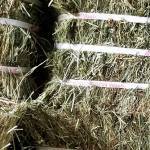Tokyo Olympics: Feed and Forage Facts

The Tokyo Olympics, postponed a year due to the coronavirus pandemic, wrapped up on August 8, 2021. The three equestrian disciplines, dressage, eventing, and show jumping, took place July 24-August 7 across two venues, the Baji Koen Equestrian Park and the Sea Forest Cross-Country Course, situated on an island in Tokyo Bay.
A record number of 50 countries competed in the equestrian events this year due to a change in format that limited teams to three members each and allowed for more countries to be represented on the Olympic stage. The breakdown by sport:
- Show jumping: 35 countries, 20 teams, 75 horse/athlete combinations,
- Eventing: 29 countries, 15 teams, 65 horse/athlete combinations, and
- Dressage: 30 countries, 15 teams, 60 horse/athlete combinations.
Nearly 250 horses traveled to Tokyo for the Olympic Games aboard eight horse flights. Understandably, so many high-performance athletes required a substantial amount of feed and forage to stay in peak shape for the competition. Kentucky Equine Research has a history of working behind the scenes at top international equestrian events, including six other Olympic Games, and was able to serve as a consultant to JRA Facilities Co. Ltd., the organization responsible for procurement and importation of feed and bedding for the event. Kentucky Equine Research assisted the national federations in placing orders, sourcing products, and providing support to the team that fulfilled on-site orders for feed, hay, and bedding.
At past Olympic Games, the bulk of available hay was timothy, a type not commonly fed in Europe. Kentucky Equine Research assisted in coordinating an advance shipment of 1,200 double-compressed, half-cut timothy hay bales to 30 locations across eight countries in Europe, to ensure a proper transition between forage types was available to the competing horses. See video.
Additionally, other feedstuffs were procured for the Olympics, including around:
- 3,900 lb (1,750 kg) of apples,
- 10,700 lb (4,870 kg) of carrots,
- 1,600 lb (720 kg) of steam-rolled oats,
- 970 lb (440 kg) of whole oats, and
- 400 lb (180 kg) of wheat bran.
Horse managers had several types of hay to choose from including first- and second-cut timothy hay and alfalfa (lucerne) hay from Anderson Hay and Grain Company in Washington state, in addition to bagged haylage from New Zealand and Lithuania. Of these options, around the following amounts were used:
- 4,000 lb (1,800 kg) Alfalfa (4.5%)
- 24,200 lb (11,000 kg) first-cut timothy hay (28%)
- 48,400 lb (22,000 kg) second-cut timothy hay (55%)
- 11,000 lb (5,000 kg) haylage (12.5%).
Due to the timing of the event, the summer heat was in full force, and even with later start times for competition, the weather took a toll on athletes. To combat lasting effects, many horse managers chose to encourage hydration and aid in electrolyte replacement using KER products, including Restore® Electrolyte Powder and Restore Paste, as well as Drink-Up™.
Feeding and housing some of the world’s top four-legged athletes is a formidable task that relies on logistical precision. Because format changes will allow more countries to be represented in the Games, the next Summer Olympics may see even more horses compete.








